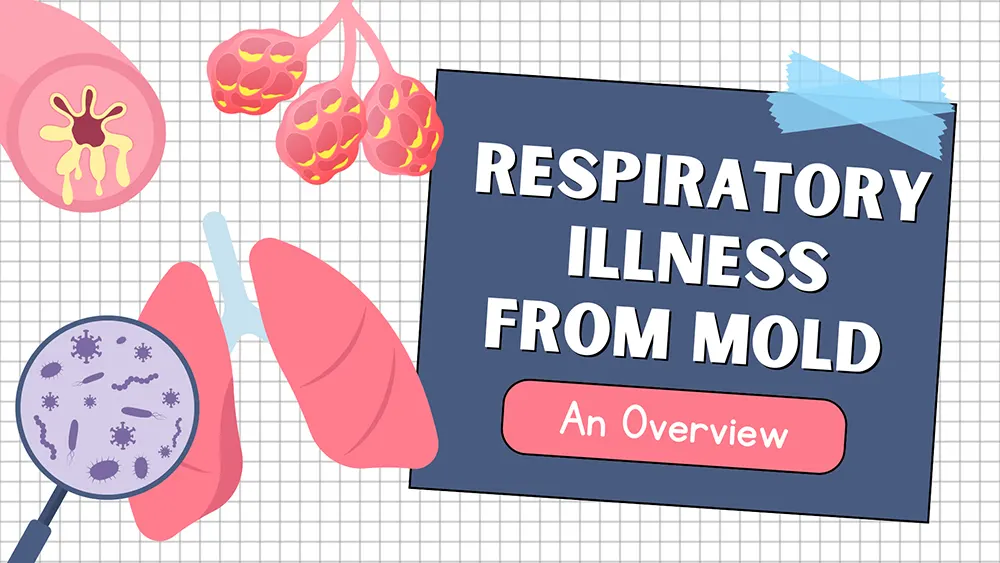Mold exposure can lead to serious respiratory illnesses, including asthma attacks, chronic coughing, and long-term lung damage. Mold spores are microscopic airborne particles that thrive in damp environments, infiltrating homes and workplaces without detection. Once inhaled, these spores trigger inflammatory responses, making breathing difficult and worsening existing lung conditions.
Individuals with respiratory sensitivities—such as asthma sufferers or those prone to bronchitis—are especially vulnerable to mold-related health complications. Prolonged exposure to mold can weaken the immune system, intensify breathing difficulties, and, in severe cases, lead to permanent lung damage.
This guide explores how mold contributes to respiratory illnesses, key symptoms to watch for, and expert-backed solutions to eliminate mold and improve indoor air quality.
Protect Your Health—Schedule Your Free Mold Inspection Today!
How Mold Causes Respiratory Illness
Mold spores are tiny airborne particles that, when inhaled, can cause lung inflammation and serious respiratory illnesses. These microscopic spores float undetected in indoor spaces, settling into humid corners, air ducts, and damp surfaces. When inhaled, they activate immune responses, causing irritation, mucus buildup, and restricted airflow.
For individuals with respiratory conditions, mold exposure can escalate minor symptoms into chronic health issues. The body reacts to mold particles as harmful intruders, triggering inflammation that blocks oxygen flow and disrupts lung function. This reaction leads to persistent coughing, wheezing, and difficulty breathing.
Long-term exposure to toxic mold varieties—such as black mold—can cause neurological symptoms (such as memory loss, coordination issues, mood changes, and memory loss), immune system problems, and in more sever cases, organ damage. Without proper mold remediation, symptoms may worsen over time, requiring medical intervention to manage declining lung health.
Common Symptoms of Respiratory Illness from Mold Exposure
Exposure to mold can cause persistent coughing, wheezing, and shortness of breath, which may worsen over time. When mold spores enter the lungs, they trigger inflammatory responses, leading to airway irritation and breathing difficulties. Over time, prolonged exposure can contribute to chronic respiratory conditions, making recovery more challenging.
Early Symptoms of Mold-Related Respiratory Illness:
- Persistent Cough: A dry or phlegmy cough that lingers longer than usual.
- Shortness of Breath: Difficulty breathing, even in environments that seem clear of irritants.
- Nasal Congestion and Sneezing: Mold spores can trigger allergic reactions similar to seasonal allergies.
- Throat Irritation: Scratchy or sore throat from inhaling mold-contaminated air.
- Acute Symptoms That Indicate Severe Mold Exposure
- Wheezing and Chest Tightness: Airway inflammation can make breathing increasingly difficult.
- Sinus Pressure and Headaches: Mold-related sinus infections can lead to discomfort in the nasal passages.
- Eye Redness and Irritation: Exposure to mold spores may result in eye inflammation.
- Fatigue and Dizziness: Mold toxins can weaken immune function and impact overall energy levels.
Chronic Symptoms from Long-Term Mold Exposure
- Recurring Bronchitis or Pneumonia: Prolonged exposure can lead to frequent lung infections.
- Asthma Development or Worsening: Mold can trigger or exacerbate asthma attacks.
- Hypersensitivity Pneumonitis: An immune response causing lung inflammation and long-term scarring.
- Reduced Lung Function: Chronic exposure may lead to irreversible damage, restricting airflow and oxygen absorption.
If you experience any of these symptoms, professional mold inspections and air quality assessments can help identify hidden contamination and reduce health risks.
Mold Hotspots in Homes That Cause Respiratory Illness
Mold thrives in humid areas, making locations like bathrooms, basements, and poorly ventilated spaces high-risk zones for respiratory illnesses. Identifying mold-prone areas is essential for preventing exposure and improving indoor air quality.
Common Areas Where Mold Grows Indoors
- Basements: Poor air circulation and moisture buildup promote mold growth on walls, floors, and storage items.
- Bathrooms: Persistent humidity from showers and sinks leads to mold infestations in grout, ceilings, and behind wallpaper.
- Kitchens: Leaks under sinks and condensation around appliances create hidden mold contamination.
- HVAC Systems: Mold spores can spread through air ducts, affecting air quality in every room.
- Attics: Inadequate ventilation and roof leaks make attics a common mold hotspot.
- Damp Furniture and Carpeting: Mold can develop in upholstery and rugs, leading to long-term exposure risks.
Routine mold inspections and moisture control solutions help reduce respiratory risks and prevent mold-related health complications.
Why Professional Mold Removal Is Essential for Respiratory Health
For those concerned about respiratory health, professional mold remediation is the safest way to eliminate mold and improve indoor air quality. While DIY mold removal may seem like a simple solution, it often fails to address hidden mold infestations, leaving spores behind that continue contaminating the air. Without thorough removal, mold can spread to new areas, causing persistent respiratory issues and increasing the risk of long-term lung damage.
How Mold Removal Experts Protect Your Home and Health
At Mold Removal Experts, we provide trusted solutions to protect your home and health from mold-related respiratory risks. Our specialized services target hidden mold contamination, moisture control, and long-term prevention, ensuring clean air and a safer living environment.
Our Expert Mold Remediation Services
- Encapsulation for Long-Term Mold Prevention: Seals contaminated areas to prevent future mold growth.
- Basement Waterproofing and Drainage Systems: Eliminates moisture buildup to stop mold from spreading.
- High-Performance Dehumidifiers: Reduces humidity levels to prevent mold recurrence.
- Advanced Air Filtration Solutions: HEPA filters remove airborne mold spores and allergens.
- Comprehensive Mold Inspections and Testing: Identifies hidden mold and provides targeted remediation.
For those experiencing respiratory issues due to mold exposure, expert mold removal and preventative solutions are essential to maintaining a safe and breathable home.
Final Thoughts – Respiratory Illness from Mold
Respiratory illnesses caused by mold exposure can be dangerous—but professional remediation and air quality solutions can restore safety and comfort. Mold contamination doesn’t go away on its own, and delaying removal can lead to lasting lung damage. Investing in expert mold remediation, air purification, and moisture control helps prevent exposure and ensures healthier indoor air.
Protect Your Health and Home—Schedule Your Free Mold Inspection Today!

